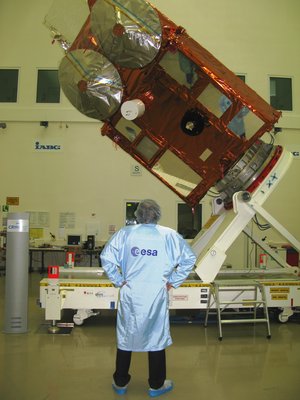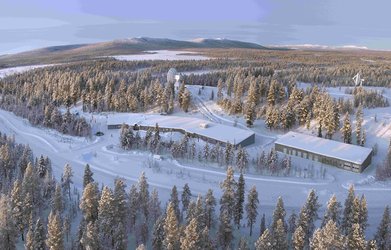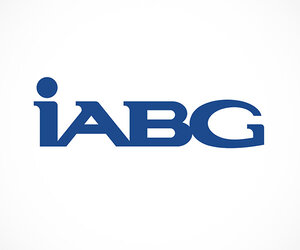CryoSat: green light for launch campaign
ESA’s CryoSat ice mission has completed its Flight Acceptance Review, confirming that all the mission components are ready for launch, which is planned for
This formal review is an important part of the process to ensure that all the parts of the mission are in place. It is focused on the readiness of the satellite and the preparation of the launch campaign, but also heard reports of the successful Ground Segment Acceptance Review completed in July and the status of the launcher. Although there will be future checkpoints along the road to the launch pad, this was the last major hurdle.
Generally happy with the status of the satellite, the Board requested to be informed of the progress on a few outstanding analyses that are due to be completed in mid-December. Currently in storage at IABG’s spacecraft test centre in Ottobrunn, Germany, the CryoSat-2 satellite, built to replace the original CryoSat lost in a launch failure in 2005, will be shipped to the Baikonur launch site in Kazakhstan on 12

Once the satellite has safely arrived at the integration facilities at the launch site, it will undergo final testing before joining the launch vehicle. CryoSat-2 will be taken into orbit on a Dnepr launch vehicle, which is based on the SS-18 intercontinental ballistic missile.
“We are looking forward to starting the launch campaign and finally getting the satellite into orbit. It’s been a long wait since we lost the first CryoSat four years ago, but now the tempo is stepping up and we’re again on the threshold of adventure,” said Richard Francis, the CryoSat Project Manager.

From an altitude of just over 700 km and reaching latitudes of 88°, CryoSat will precisely monitor changes in the thickness of sea ice and variations in the thickness of the ice sheets on land. These data are urgently needed by scientists to understand exactly how Earth’s ice is changing in response to climate change. For over 15 years, the ERS satellites and Envisat have been mapping the extent of ice cover. However, in order to understand how climate change is affecting the sensitive polar regions, there is an urgent need to determine exactly how the thickness of the ice is changing to get the full picture.
Following on from GOCE, which was launched in March this year and now delivering detailed data on Earth’s gravity field, and SMOS, which was launched less than three weeks ago and will take measurements of soil moisture and ocean salinity for a better understanding of Earth’s water cycle, CryoSat will be the next of ESA’s Earth Explorer satellites in orbit.
Launching three missions dedicated to improving our understanding of the Earth system within 12 months will mark a significant step in ESA’s Earth Observation Programme.















 Germany
Germany
 Austria
Austria
 Belgium
Belgium
 Denmark
Denmark
 Spain
Spain
 Estonia
Estonia
 Finland
Finland
 France
France
 Greece
Greece
 Hungary
Hungary
 Ireland
Ireland
 Italy
Italy
 Luxembourg
Luxembourg
 Norway
Norway
 The Netherlands
The Netherlands
 Poland
Poland
 Portugal
Portugal
 Czechia
Czechia
 Romania
Romania
 United Kingdom
United Kingdom
 Slovenia
Slovenia
 Sweden
Sweden
 Switzerland
Switzerland































